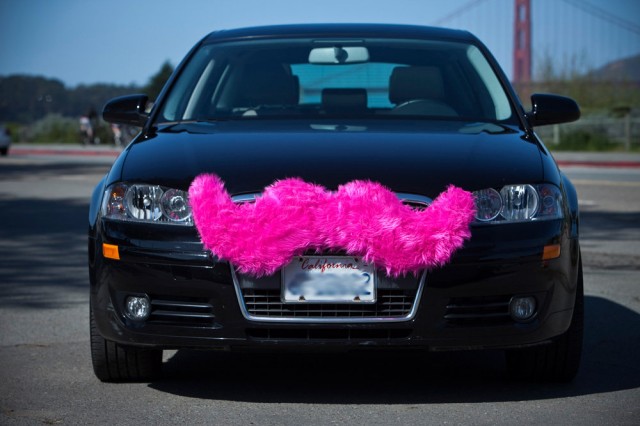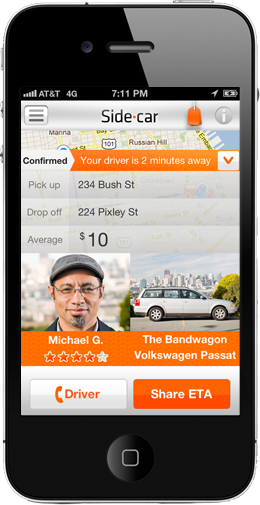
Update: We reported in July on the rise of two San Francisco ridesharing startups, Lyft and SideCar. Both companies have since expanded their reach in the Bay Area, and have yet to run into any thorny legal issues so far. These ride-sharing companies claim that they are not taxi companies, even though they act very similar to taxi companies. The pair is serving a much smaller area than Uber, a smartphone-powered black-car service focusing on the upper tier of the market.
Uber, which also operates in San Francisco, has been facing increasing legal scrutiny in cities around the country. Last week, Washington, DC, again proposed new anti-Uber regulations, this time banning car firms with less than 20 cars in their fleet. Recently, though, the company beat back a state-issued cease-and-desist order in Massachusetts to successfully launch in Boston. Uber—which still operates in San Francisco—remains under investigation by the California Public Utilities Commission, the state agency that regulates limousines. As Lyft and SideCar expand in the City by the Bay, they may end up facing similar legal challenges.
SAN FRANCISCO—As I drove over the Bay Bridge and passed into the city on a recent Friday afternoon, I faced a crisis of will. Was I truly willing to attach a hot pink Carstache—which is precisely what it sounds like—to the grill of my black Toyota in the name of journalism?
I pulled onto Harrison Street, into a section of the SoMa (South of Market, San Francisco’s startup hub) district that's full of new high-rise residential buildings. I stepped out into the summer afternoon, opened my trunk, and whipped out the ridiculously large but definitely distinctive Carstache. I walked to the front of my car and did the deed. Carstache affixed. Now I was set to begin my first work shift.
Last week, I completed my orientation and training as a driver for Lyft. It's the new service from Zimride, a ride-sharing website started back in 2007. Lyft launched in limited form back in late May. Its goal? To connect drivers and passengers through the company’s free iPhone app. In essence, it’s a social, tech-driven way to compete with taxis (notoriously difficult to find in San Francisco). Think AirBnB—another local startup that lets people worldwide rent out their extra rooms, apartments, homes, teepees, and yurts—but for cars.
Lyft isn’t the only company offering this type of service; the similar SideCar just launched in June. So over the last two weeks, I became a registered driver on both sites. And I'm one of the first. I’m fairly certain at the time of this article, I’m one of the first 50 drivers on Lyft and one of the first 100 drivers on SideCar. In effect, I’ve begun moonlighting as a very part-time not-quite-taxi driver.
With Carstache in place, I spent 90 minutes tooling around various neighborhoods. Mission District, Potrero Hill, North Beach, the Financial District—all without seeing a single request (and worrying often that the Carstache might fall off). Finally I got the first signal. My first pickup was only five minutes away. As soon as I accepted the mission, I rolled from the Financial District back down into SoMa to pick up a guy named Matt. In his user icon, he appeared to be hugging an original Macintosh. Matt also had a perfect 5.0 customer rating. I liked him already.
I rolled up sportin’ the ‘stache and parked for a minute in front of his building. When Matt came down, I greeted him with the traditional Lyft greeting (I've been trained on this!): a fist-bump.
I invited Matt to sit up front and adjust the music as he liked. After all, I've been told to treat him just as I would any other friend riding with me. I even invited Matt to use the extra USB jack to charge his iPhone—Lyft provided one for me and the passenger to juice up during the ride.
With Lyft, the passenger tells me where he or she wants to go (maximum 60 mile radius). When the ride ends, the Lyft app provides a “suggested donation”—about 20 percent lower than what a cab would charge for the same fare.
“Where we headed?” I asked Matt.
“SFO,” he said.
“We can do that,” I responded cheerfully, remembering the training mantra that Lyfters should smile a lot. I pulled away from the curb.
Matt worked for Path and was on his way to Las Vegas for a friend’s bachelor party. I looked him up later and learned that he was Matt Van Horn, who had helped found Zimride, Lyft’s parent company. Later, by e-mail, he elaborated on his connection to the company, he's “a shareholder, power user of Lyft, and friend of the company." He was happy to describe his previous 30 ride experiences too.
“All have been positive,” he wrote. “Everyone has been really accommodating, kind, and fun. I had one driver who picked me up from my apartment to take me to a haircut, then asked if I wanted him to stay in the area in case I wanted a ride to work after. After my 10 minute haircut, I already had a Lyft ready to take me to work and it literally took 20 minutes out of my day instead of the usual hour it takes for a haircut.”
Once I dropped Matt off, I gave him a 5-star rating and hoped that he’d do the same for me.
My first experience proved fairly typical. After a few hours on duty, you quickly realize two things: 1) the hotspot pickup area is near downtown in the late afternoon and 2) the pink Carstache definitely gets attention.
“I’ll be parked somewhere and then ten people will walk by and say, ‘Whoa, look at that pink mustache,’” Nancy Tcheou, 25, a fellow Lyft driver, told me last Monday by phone. “I’ve had at least three people take a picture of it while I was parked, in the car. It’s been really entertaining.”
"If it walks like a duck..."

The Bay Area is no stranger to innovations in transportation. For decades now, the “casual carpool” system has offered an inexpensive way for East Bay passengers to get to San Francisco. It saves everyone time and money (no one will complain about paying less for the westbound bridge toll). For over a decade, the city has also had official carsharing companies and non-profits operating within its 49 square miles. This fall, San Francisco is even expected to launch a bike-sharing service.
San Francisco has a burgeoning tech-transportation scene, too. Just last year, the company Getaround launched; allowing individuals to turn their personal vehicles into car-shares. Established companies like Cabulous and Uber recently announced an expansion of their consumer offerings in San Francisco, too.
Yet despite the various transport options, San Francisco has less-than-stellar taxi service. I live in Oakland and never take taxis, but this is what people, online and offline, tell me.
Both Lyft and SideCar have the potential to shake up the local transportation industry further, but only if their business is acceptable to the powers that be. Sure, it's neat to catch a ride from another tech-savvy human rather than from an anonymous taxi driver who might be more interested in blabbing away on his phone than in catering to you. But lawyers and city officials say that both companies might be in conflict with local taxi law.
Lyft and SideCar both insist, however, they are simply ride-sharing companies, not taxis operators. In essence, I drove around like a taxi and dropped people off like a taxi, but both companies say that I’m definitely not a taxi. I’m not getting paid for fares; I'm getting a voluntary “donation.” (Of course, low customer ratings received after underpaying too often would probably result in a rider not getting rides in future).
For instance, SideCar says in its Terms of Service:
“Passenger agrees that Passenger shall solely use SideCar for personal, ride-sharing purposes only, and shall not use SideCar for any commercial purposes. Use of SideCar ride-sharing for any commercial purposes (as determined by SideCar in its sole and absolute judgment) shall result in immediate termination of Passenger’s account. Passenger expressly acknowledges that SideCar is solely a ride-sharing marketplace, and not a common carrier, limousine or taxicab service, or travel agent.”
I ran the idea past the former deputy director of the San Francisco Taxi Commission, Jordanna Thigpen. Despite what the companies say in their own legal documents, the judicial system may have its own view.
“Sometimes in the law, judges will interpret a statute [in this way]: if it looks like a duck, if it walks like a duck, it’s a duck,” said Thigpen, now an attorney with Cotchett, Pitre, and McCarthy.
In her former position as enforcement and legal affairs manager for the taxi division of the San Francisco Municipal Transportation Authority, Thigpen said that she would focus largely on safety. She frequently checked (among other things) not just that the vehicle in question had insurance at the time of inspection, but that there was continuous coverage—as the law requires of taxi companies.
Under the San Francisco Municipal Code, Section 1105, Paragraph A, Subsection 1, if a court finds either service to be a “Motor Vehicle For Hire,” they would likely be required to obtain permits issued by the SFMTA.
“[Lyft and SideCar] are trying to put themselves in this netherworld of regulation,” Thigpen said. “The determination is: how is a court going to interpret the definition of ‘for hire’ vehicle?” For now, company representatives insist they are not a "vehicle for hire."
"We’ve worked with transportation legal experts who confirm we are abiding by current laws," said John Zimmer, the founder of Zimride, in an e-mail sent to Ars. "Lyft is a community based ride-sharing service that is an extension of our existing long distance ride-share model. We use optional donations as a way for drivers to reimburse the costs associated with owning and operating a vehicle."
reader comments
116